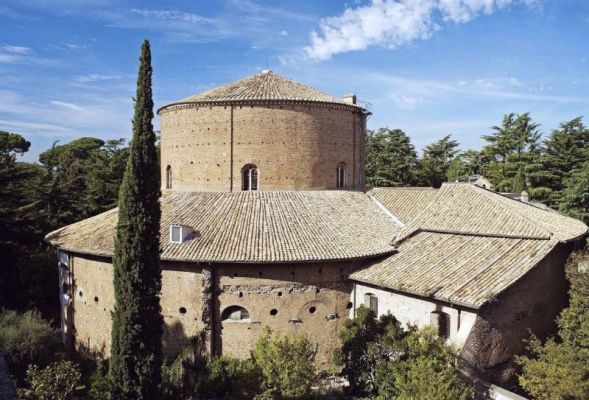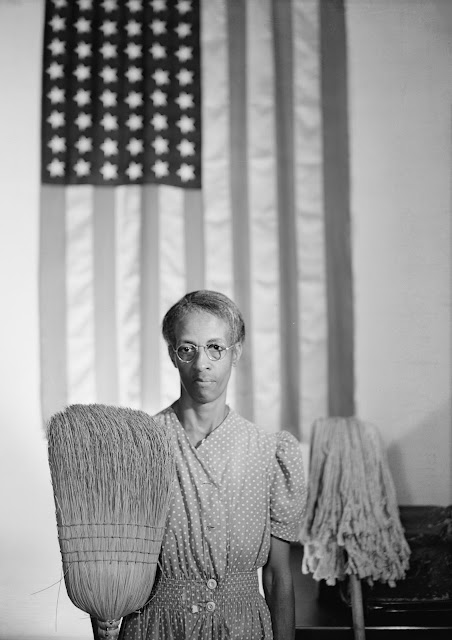The first post in this series can be found here.
It's remarkable to realize that the domed church came late to Rome. The city famous for St. Peter's and it's many domed churches did not see any domed construction after the 5th century until the 16th century. All the major developments in domed church architecture took place in the Greek speaking Eastern Roman Empire, or as we know it, the Byzantine Empire, and didn't find their way to the city of Rome until Bramante built the Tempietto. While major inventions such as the dome resting on four arches and the dome clerestory took place in the Christian East, the city of Rome planted the seeds of those ideas in some of its earliest surviving Christian structures and churches.

We get a small preview of things to come when Christianity was still an illegal spiritual movement widely loathed and feared in the Roman Empire, in the ancient Christian catacombs. While Rome in various periods of persecution destroyed churches and burned Christian books, it spared Christian burial places. Roman superstitions about the dead preserved Christian cemeteries. The first identifiably Christian art appears in the 3rd century when large numbers of educated and well to do Romans begin converting to the new religion during the Third Century Crisis. They brought their pre-Christian culture of imagery and reverence for the dead into the new faith. They also brought the Roman institution of the family tomb into the underground Christian cemeteries that once honeycombed the bedrock outside the city walls, the catacombs. We see in these photos a cubiculum, a family tomb chamber in the Catacombs of Priscilla north of the Vatican in Rome. All the burials in this room belonged to a single family.

The Room of the Veiled Lady in the Catacomb of Priscilla.
The Veiled Lady, perhaps a personification of prayer. She wears something that looks to me like a tallit.
She raises her hands in what was once the universal gesture of prayer throughout the ancient Mediterranean world. Today that gesture survives in Islam and in the gesture of priests saying the Eucharistic Prayer in Western liturgy.
The Good Shepherd in the ceiling of the Room of the Veiled Lady in the Catacomb of Priscilla. The passage in the Gospel of St. John where Jesus declares himself to be the Good Shepherd of the Sheep almost certainly inspired this image. It is likely a repurposed borrowing from Classical art of Apollo or Mercury as guardian of flocks.

A family cubiculum in the Catacomb of St. Marcellinus and St. Peter. After of the Great Fire of 64, Christianity became illegal throughout the Empire on the decree of the Emperor Nero who blamed Christians for the catastrophe. Nero declared that the fire was punishment from the gods for tolerating the presence of impious and seditious Jewish heretics. For the first two centuries of its existence, there was no identifiably Christian art. The first generations of Christians were largely from marginal classes; slaves, freedmen, the poor, and women. The Jewish prohibitions on imagery still had force for these first adherents of a religion that came out of Judaism. Among these congregations of poor and marginalized people there were no funds for making art. Christianity in its beginnings was an apocalyptic religion that proclaimed the imminent end of the world. The earliest generations of Christians expected to see the end of the world and the Second Coming of Christ in their lifetimes. What was the point of making durable works of art in a doomed world?
The earliest identifiably Christian art appears in the city of Rome in the third century when large numbers of educated and affluent Romans began converting to the new religion in the course of the Third Century Crisis. Theirs was a culture of the image where ideas and concepts were visualized in stories and personifications. They naturally and inevitably brought that culture into Christianity.
The Roman Empire during its periodic persecutions of the religion destroyed early church buildings and early Christian books. But, Roman superstitions about the dead protected Christian cemeteries. The earliest surviving Christian art comes from underground cemeteries outside the city walls of ancient Rome called catacombs.
The ceiling of the cubiculum in the Catacombs of St. Marcellinus and St. Peter.
We hardly recognize this ceiling painting as Christian at all. None of the familiar symbols and images of Christianity appear anywhere, no crosses, no images of Christ, no Virgin Mary, no saints. At first glance, this ceiling painting does not look much different from any other tomb imagery of the period.
In the center medallion we see The Good Shepherd, but this would not automatically identify this as a Christian burial. He could be Apollo Protector of Flocks, or Mercury another Protector of Flocks and a Bearer of Souls to the underworld. The story told in four panels between praying figures is the story of Jonah. In the undamaged panels we see Jonah thrown overboard and swallowed by the whale. The whale spits up Jonah on the beach before Nineveh, and finally there is Jonah resting under the gourd vine.
It's possible that the artists employed in painting these tombs may not have been Christians themselves. They were maybe second or third string house painters hired for a another tomb job for another mystery religion. They borrowed heavily from what they already knew, the stories from Classical mythology. Jonah under the gourd vine looks like Bacchus under a grape vine arbor.
Early Christian architecture -- at least what survives -- does not appear until after the Emperor Constantine ended Christian persecution with the Edict of Milan in 313 and afterwords gave the religion state patronage (though Christianity would not become the state religion of the Roman Empire until the Edict of Thessalonica under Emperor Theodosius in 380).
Most of the early churches built by Constantine and his successors were adaptations of the Roman basilica, originally secular government buildings with a long center hall lit by clerestory windows and flanked by columned aisles. Much less common were round churches built for the ritual of circumambulation, walking around a holy site, usually a saint's tomb, always keeping it to your right. In ancient times all religious people in the Mediterranean world practiced circumambulation. Today it mostly survives in Islam. Early Christians circumambulated, and round churches were built for that ritual.
A round church built for circumambulation would seem to be a natural for a domed ceiling. Not necessarily.
The Church of Santo Stefano Rotondo in Rome originally built for circumambulation around the tomb of St. Stephen the First Martyr whose remains were brought to Rome from Jerusalem in the 5th century.
The church has a wide circular aisle for crowds of people circling the tomb of St. Stephen. Originally this wide single aisle was two aisles divided by columns recycled from earlier temples.
Over the center altar, there is not and never was a dome, only a ceiling held up by an arch on a pair of ancient columns.
The circular aisle or ambulatory of Santo Stefano.
The circular church of Santa Costanza in Rome is the only church that survives intact from Constantine's reign. The Emperor built immense churches in Rome, St. Peter's and the Lateran Church, and the Church of the Holy Sepulcher in Jerusalem. Hardly a scrap of those original churches survive. St. Peter's and the Lateran Church were completely rebuilt and the Church of the Holy Sepulcher was destroyed and rebuilt many times over.
The Church of Santa Costanza was originally attached to the larger church of Santa Agnese that is now ruined. This was the only domed church in Early Christian Rome.
The very beautiful interior of Santa Costanza, built as a burial place for the Emperor's sainted daughter in a great porphyry sarcophagus that now stands in the Vatican Museums. There is a copy in the church.
The Sarcophagus of St. Constantia or Costanza in the Vatican Museums.
The ruins of the Church of Sant' Agnese next to the Church of Santa Costanza.
A single ambulatory with doubled columns supporting masonry arches circles the center rotunda of the church. The columns are all spolia, columns taken from earlier temple and reused in the church. They appear to come from many different temples. Columns and their capitals don't always fit together and impost blocks assist a few columns that are slightly too short.
On the vaulted ceiling of the ambulatory is the one and only mosaic to survive from the time of the Emperor Constantine, among the very earliest of Christian mosaics.
At first glance, these mosaics don't look particularly Christian. They are part of the syncretic Christianity of the Emperor Constantine that would make later theologians very uncomfortable. Constantine attributed his victory over his rival Maxentius at the Battle of the Milvian Bridge to Christ the Christian god. He built votive monuments in thanksgiving to that god as would any of his predecessors on the imperial throne.
I find these ancient Roman floor mosaics now moved to the ceiling to be very beautiful. The Roman household imagery of birds, flowers, fruit, and still life items take on a new religious dimension.
More of these very Roman domestic ceiling mosaics given a whole new dimension of meaning by their presence in a church.
The original dome mosaics, perhaps from the 5th century, do not survive except in a 16th century drawing by Francisco Hollanda. The decayed 16th century fresco on the domed ceiling may be an imaginary reconstruction of that original mosaic cycle.
The Church of Santa Costanza may well be the last dome built in ancient Rome. The city that pioneered domed architecture would not see another dome built within its walls until the 16th century.
In the meantime, ambitious and inventive domed architecture moved far to the east in the Byzantine Empire and later in Islam.
The domes of the Church of Hagia Sophia in what is now Istanbul from the 6th century.
The north dome chamber of the Masjid i Jami in Isfahan, Iran, 11th century.








.jpeg)
.jpeg)
.jpeg)


.jpeg)
.jpeg)













.png)














.jpg)

.jpg)
















